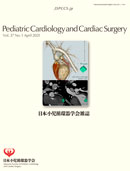Volume 37, Issue 1
Displaying 1-12 of 12 articles from this issue
- |<
- <
- 1
- >
- >|
Preface
-
2021 Volume 37 Issue 1 Pages 1
Published: April 01, 2021
Released on J-STAGE: November 17, 2021
Download PDF (105K)
Review
-
2021 Volume 37 Issue 1 Pages 2-9
Published: April 01, 2021
Released on J-STAGE: November 17, 2021
Download PDF (2929K) -
2021 Volume 37 Issue 1 Pages 10-17
Published: April 01, 2021
Released on J-STAGE: November 17, 2021
Download PDF (2616K)
Original
-
2021 Volume 37 Issue 1 Pages 18-26
Published: April 01, 2021
Released on J-STAGE: November 17, 2021
Download PDF (454K) -
2021 Volume 37 Issue 1 Pages 29-34
Published: April 01, 2021
Released on J-STAGE: November 17, 2021
Download PDF (367K)
Case Report
-
2021 Volume 37 Issue 1 Pages 35-41
Published: April 01, 2021
Released on J-STAGE: November 17, 2021
Download PDF (7542K) -
2021 Volume 37 Issue 1 Pages 44-50
Published: April 01, 2021
Released on J-STAGE: November 17, 2021
Download PDF (5439K) -
2021 Volume 37 Issue 1 Pages 51-56
Published: April 01, 2021
Released on J-STAGE: November 17, 2021
Download PDF (3701K) -
2021 Volume 37 Issue 1 Pages 57-63
Published: April 01, 2021
Released on J-STAGE: November 17, 2021
Download PDF (1047K) -
2021 Volume 37 Issue 1 Pages 64-69
Published: April 01, 2021
Released on J-STAGE: November 17, 2021
Download PDF (3291K)
Editorial Comment
-
2021 Volume 37 Issue 1 Pages 27-28
Published: April 01, 2021
Released on J-STAGE: November 17, 2021
Download PDF (135K) -
2021 Volume 37 Issue 1 Pages 42-43
Published: April 01, 2021
Released on J-STAGE: November 17, 2021
Download PDF (151K)
- |<
- <
- 1
- >
- >|
